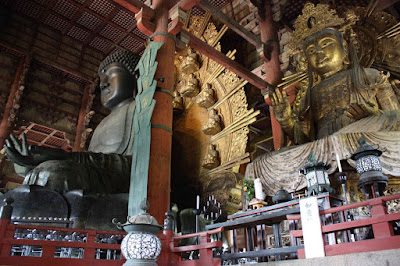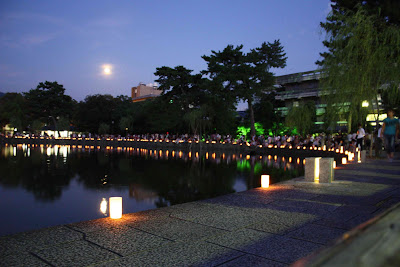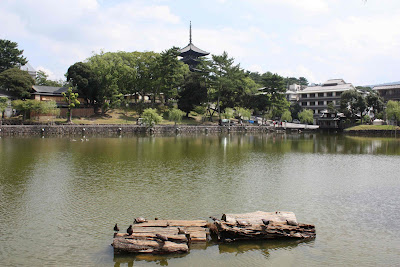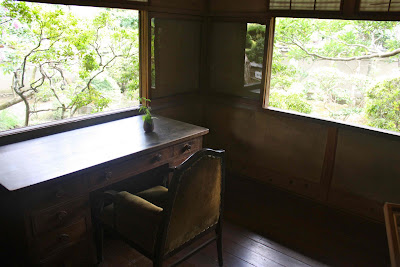I went to Nara last weekend during the summer lantern festival, known in Japanese as Tokae. The O-Bon lanterns are meant to guide the spirits of the deceased, and they are placed at various points throughout the city––around the perimeters of ponds, in open areas of Nara Park, before shrines and temples, and along many streets and sidewalks.
This was my second trip to Nara, and the deer here, though considered sacred by the Japanese, are just as aggressive as they were when I was in Japan as a university student. Walking away does absolutely no good when you've got food in your hands.
The only possible thing that might keep these deer from nosing tourists for food is the need for shuteye. And in the summer heat, which has consistently been around 35 C (95 F) in Nara and Kyoto, it's understandable.
Most deer stay in grassy areas, but others seem to like to express their individuality by lying in gutters alongside busy roads.
The smart ones head for the water. Unfortunately, smart appears to be relative as they pee and poop in the water they drink from and cool down in.
The Nara National Museum I found disappointing. Both buildings were filled with religious art, which is interesting; in these exhibitions, however, they were under-explained, and I thought the exhibitions could have been a bit more diverse.
The cafe at the National Museum specializes in Chinese food. It wasn't anything to write home about...does blogging about it count as the same thing?
If only that deer knew how to work the faucet on that hose...
Nandaimon Gate, which one normally passes through on the way to Todaiji Temple. On each side of the interior passage are two scary-looking Nio guardians from the 13th century, considered by some to be the finest examples in the world of such wood-carving.
Here's one of the Nio guardians. He's so fierce and nasty-looking that they keep him behind a fenced enclosure.
This one, too.
Todaiji-Temple, a World Heritage site and possibly the most popular destination for tourists to Nara. The Daibutsu-den Hall here is the biggest wooden building in the world, and used to be almost 50% larger than it is now.
Check out the height of those doors.
One of the two giant Buddha figures in Daibutsu-den Hall.
The original bronze Buddha was cast in 746, then was re-cast nearly 1000 years later. It's one of the largest bronze figures in the world.
I'm not quite sure what this is meant to be, but lots of people were standing around it and touching the folds of the figure's robe as if that would bring good luck.
Another angle of Todaiji Temple.
Cutting through the park to get to Nigatsu-do Hall, another World Heritage site, one can pass beneath this bright vermilion torii.
That's Todaiji Temple in the background. It's so huge that it ends up being in the background for quite a while after you've left it.
Some stone kami on the side of a walking path, obviously well-tended to.
Some fenced in rice between temples.
A picturesque path on the way to Nigatsu-do Hall.
Japan's temples blend well with nature and vice-versa. I liked how these old tree branches framed the wooden doors of this building at Nigatsu-do.
Of course, no temple in Nara would be complete without a handful of deer munching on grass and pooping in unexpected places.
The temple offers fantastic views of Kyoto and its forested mountains. I wish I'd come here at dusk, actually.
Back in town, after a much-needed shower and replenishing of liquids, we found the city gearing up for the lantern festival.
They poured water in the candle holders and then floated the candles on top.
Many streets here are already picturesque without the lanterns, though the lanterns do give the place an ethereal feel.
Once place we stopped at along Naramachi Road.
Lanterns were placed around the perimeter of Sarusawa-ike Pond, which was full of people well before the sun went down.
One of the nicest things about this setting was the silhouettes of temples and pagodas against the darkening sky.
Here you can see the Five-Story Pagoda all lit up behind a lantern-strewn hillside.
Here are some red lanterns in a bizarre, never-before-seen shape.
Some of the local ryokans even got in on the act. I only wish I'd known beforehand that it wasn't "cool" to do a full-body, rolling, head-first slide through the displays.
It was nearly impossible to find a place to eat that either wasn't packed or didn't have a long wait.
As you can see, the place wasn't crawling with eater. Though it had been about 20 minutes before we decided to enter and order something to eat.
I went with a bowl of chicken oden and two pieces of pressed mackerel sushi wrapped in leaves. Neither was earth-shatteringly good, but the cost was decent––about 900 yen, or under US$12.
Filled up now with food, we headed back to Kofukuji Temple and its neighbor, Five-Story Pagoda, where more lanterns had been placed. Here you can see the kanji for "harmony."
The moon cooperated fairly well most of the night and appeared at convenient times. Here it can be seen between the Five-Story Pagoda and Tokon-do (East Buddha Hall).
Here it is again hovering over the lantern-bright lawn between the Nara National Museum buildings.
More lanterns on the lawn of the Nara National Museum.
More of the same here...
We went from the Nara National Museum to a VERY long walk around what seemed like 80% of Nara Park. Policemen were out in force, for no discernable reason other than to make sure no one veered from the official route, which was seriously like 3 km long without a way back into the park once you'd ventured into it. We finally made it to Sagi-ike Pond, where a number of lantern-lit rowboats plied the water around Ukimido Gazebo.
Young Japanese women in kimono were out in bunches, which gave more of a festive air to the night's events.
Another shot of boats surrounding Ukimido Pavilion.
Ukimido Pavilion from a bit closer-up.
And what festival would be worth its name in Japan without food stalls specializing in yakisoba, takoyaki, shaved ice, etc.?
We got back to Matsumae Ryokan in time for a shower. In addition to a 10:30 p.m. curfew, there was a strict time schedule for taking showers and baths, and check-in and check-out times were an equally inconvenient 3 p.m. and 10 a.m., respectively. That's fairly common in Japan, however.
Breakfast the next morning was thick-cut bread, papaya and hibiscus jam, and what else––Vietnamese coffee. Making breakfast in the room was about 1/3 the cost of what it would have been elsewhere.
All wigged out on caffeine, we scrambled outside into the blazing sun and found this stone-carved boat with what appeared to be jizo figures on it.
The lake that had been decorated with lanterns the previous evening was free of them in the morning, and turtles had replaced them. (Not really, but several were sunning themselves on these half-logs.)
As usual, the deer hordes were out and looking for deer biscuits.
This one had a pretty prime spot. Even if no one has deer biscuits to give you, you might score a half-eaten or dropped ice cream cone. The deer, incidentally, would sometimes make these horrible-sounding neighs. It was almost like a pained mew. I'm pretty sure that if I were to start imitating it (as I'm prone to do with animal noises), whoever I was with wouldn't let me do it more than once before telling me forcefully to shut up.
One often finds stacked sake casks outside of shrines in Japan. Just once I'd like to poke a hole in one and see if sake comes spurting out.
The entrance to Kasuga Taisha Shrine, another World Heritage site.
Also at the shrine is this bronze deer statue. The deer here, as I said above, are considered sacred. They've been living in this park for centuries, and were originally thought to be messengers from the gods.
Kasuga Taisha was founded in 768, back when Nara served as the capital of Japan and was also the center of Buddhism in the country.
There are 3000 of these lanterns inside the Katsuga Taisha compound, which is restored once every 20 years––a tradition dating back to the shrine's origin.
That gorgeous cedar tree is 23 meters tall and more than 1000 years old.
The shrine consists of vermilion pillars as seen here, as well as white-walled buildings and rooftops constructed from cypress-bark. The shrine hasn't changed its appearance since its founding.
Hanging lanterns and vermilion pillars.
From the shrine we continued toward Shiga Naoya's Old Residence, taking Sasayakino-Komichi Path. Along the way I saw this sign. I like to think it explains the "rules of engagement" with the local deer. Kind of like a blood sport perpetrated by aggressive deer against hapless pigtailed girls and old ladies. There's the BITE, the KICK, the BUTT, and the KNOCK DOWN. Watch out!
I'd brought a novel by Shiga Naoya to Nara without realizing that he had a former home here and one could visit it.
The place is very impressive. His success as a writer was apparent, too, in the sheer size of the house and its grounds.
Not a bad place to sit and write one's novel...
He lived here from 1929-1938 and wrote Anya-Koro (A Dark Night's Passing) here. It's a dark story, but it's one of my very favorite Japanese novels.
His dining room was quite spacious, certainly large enough to host his literary friends (such as Junichiro Tanizaki, another Japanese novelist who is definitely worth reading).
His sunroom, too, was amazing. He designed the house himself.
He ended up moving to Tokyo after leaving Nara and died there at 88 years of age in 1971.
We kept walking...and walking...and walking after finishing our tour of Shiga Naoya's house. We passed by Sagi-ike Pond and Ukimido Gazebo again, though this time during the daytime.
There were quite a number of summer flowers in bloom, and one even saw the occasional rickshaw driver. It's hard to believe they survive for long in 35 C heat.
The pond again, with flowering trees in the foreground.
At 2:00 we finally opted for lunch, choosing an okonomiyaki place not far from Matsumae Ryokan.
The A/C was most welcome, as was the pitcher of ice water that we downed in about 5 minutes.
The tomato salad was refreshing...
But the grilled sea scallops were a bit dry...
The okonomiyaki was quite good, though, especially with an Asahi Draft chaser.
Our last stop of the day in Nara (before heading to the train station and promptly getting on the wrong train, which took us to Osaka rather than back to Kyoto––doh!) was yet another World Heritage site: Gangoji Temple.
By the time we got here I'd forgotten the pitcher of water I'd drunk, as well as the draft beer, and wanted to immerse my entire head (with my mouth open) in this water basin.
Gangoji Temple was formerly called Asuka Temple, though before that it was known as Hokoji Temple. It was founded in 588 (and moved to its present location in 710) and was supported to a large extent by the King of Paekche in Korea at the time.
One especially nice thing about this temple is that very few people were here. We didn't have the place to ourselves, but it wasn't overrun by tourists and a feeling of peacefulness prevailed here.
It was a short trip to Nara, but I have to say it was a fairly packed trip, too, especially considering how meltingly hot it was. Nara's an amazing place and I hope I can come back soon.





















































































